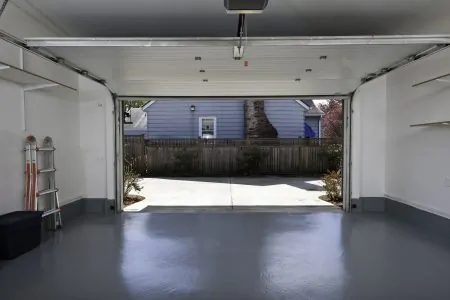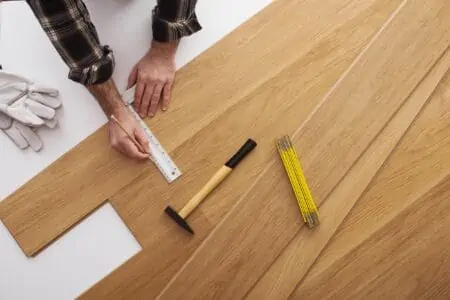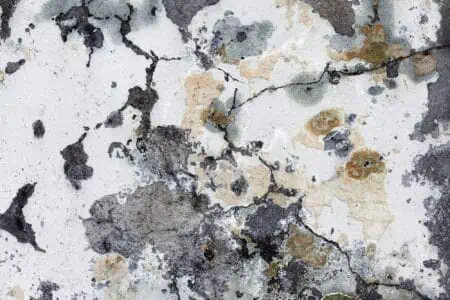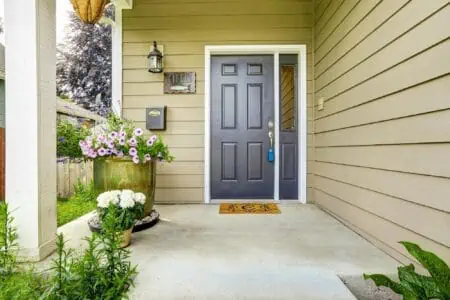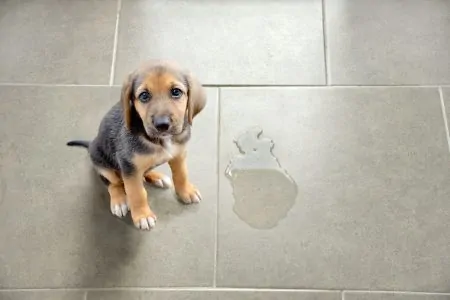Concrete flooring isn’t as durable or stain-resistant as many think. Things like water and oil can quickly penetrate the surface and leave permanent marks.
If your garage floor is looking filthy, what can you do about it?
Follow our handy guide to see how to clean garage floors (in four quick steps).
Key Takeaways
- Tidy up the garage by removing large items, protecting drywall and outlets, and sweeping away dust and debris.
- Remove stubborn stains using natural acids (like lemon juice or vinegar), detergent, kitty litter, commercial products, or by removing sealer and old paint.
- Deep clean the entire garage floor using detergent, a broom, a power washer, and a buffer.
- Maintain epoxy floors by sweeping weekly, mopping monthly, removing residue, and scrubbing stains when necessary.
There are a few steps to take to make sure you give your garage a thorough clean. It might take a whole day or two, but once it’s done, cleaning next time will be much easier.
Prepare the Garage
Before you start cleaning the floors, you’ll have to do the dreaded task of tidying. This is our three-step formula to conquer the quest:
Clear the Garage
It’s difficult to clean if you’re maneuvering around large objects. So start by removing large items such as bikes, tools, cars, boxes, basins, and other things in the way.
You may leave behind items on shelves if they aren’t in the way of water sprays, soap, or hoses.
Protect Outlets and Drywall
Drywall is especially prone to water damage if left exposed. It can become soft and weak and, therefore, lose its structure. When this happens, mold will quickly start to grow, which could become a health risk in your home (1).
To prevent this, cover at least three feet of the drywall — measuring from the floor up — with a tarp or other material. This should also protect any outlets that might be present in the garage.
Remove Dust and Debris
Sweep the floors and remove any dust, dirt, and debris that might be present. This will make the job much cleaner once you apply water and detergent.
How to Remove Stains
When the garage is clear and you’ve cleaned the floor with a broom, it’s time to focus on stains. We love these five stain removal methods.
- Time: 15-60 minutes
- Difficulty: Easy/Intermediate
1. Natural Acid
Lemon juice and vinegar are two acidic products that work effectively at removing stains. Rust is a standard stain found in the garage due to metal objects such as bikes and tools. So if you have metal lockers or standing cabinets, you might find rust stains when you move them.
Although rust can be frustrating to discover, it’s relatively easy to remove. Pour pure white vinegar or lemon juice straight onto the stain.
Allow it to sit for about five minutes before applying some elbow grease. Use a stiff brush to scrub and scour the stain away.
If this wasn’t successful and you still see the rust, you can repeat the process or use a commercial product.
You can also use muriatic acid if the stain is very persistent. This is a very acidic chemical, also known as hydrochloric acid. It’s highly corrosive, so you should handle it with care. Mix one part muriatic acid with 10 parts water.
Precaution
2. Use a Detergent
Good old powdered detergent can do wonders to various stains you might find in your garage. Get out a bucket of warm water and a box of detergent. Apply the detergent on the stain generously until covered.
Take a stiff brush and dip it in the warm water — then scrub the stain. You’ll have to apply some pressure while scrubbing. Wipe away as much detergent as you can when done and allow it to dry.
3. Kitty Litter
If you’re a cat owner who often discovers oil stains in the garage, you might just find another use for cat litter. Kitty litter is highly absorbent and can help remove oil stains without the need for chemicals.
For this method to work, however, you’ll need clay-based litter. Spread a generous amount to cover the stain and leave it overnight. Then, sweep the litter away the following day and check on the stain.
There might still be traces of the stain left the next day. If so, replace the soiled litter with a new pile and leave it overnight again. It might take a few days, but cat litter effectively removes new spills and old stains.
4. Commercial Product
When everything else fails, there’s always the option of a commercial product. There are many grease and oil removers available. They effectively remove grease, oil, brake fluid, and more from concrete.
Always follow the directions provided by the manufacturer to make sure you’re using the product correctly. Some products require a long working time of a few hours, while others only require scrubbing and rinsing straight away. However, the most effective grease and oil removers are left until dry and then removed.
5. Removing Sealer and Old Paint
If you’re planning on coating your concrete floor with epoxy, you must remove sealers and old paint.
You can use a chemical stripper to remove sealers and paint. Use your chosen chemical as directed by the manufacturer.
If you like, you can also use a solvent to remove the spots. These are quick but can have strong fumes, so keep the garage door open.
A floor grinder is also effective at removing sealers and old paint. You can rent one from your local hardware store. Use a special grind head to remove paint, mastic, and sealer.
The floor grinder will create a lot of dust, so wear a mask and goggles to stay protected. This method requires a lot less elbow grease compared to using chemicals. However, if you’re not confident using a grinder, start in a small area until you get used to the machine.
Deep Cleaning the Garage Floor
After treating spots and stains, it’s time to draw your attention to the entire floor.
- Time: 1.5-2 hours
- Difficulty: Intermediate
What You’ll Need
- Detergent
- Warm water
- Bucket
- Push broom or regular broom with stiff bristles
- Power washer
- A buffer
- Garden hose
- Floor squeegee
1. Make Your Solution
To make your cleaning solution, use any product of your choice. If you have a lot of oil spills, a degreasing product is good. You can also use regular laundry detergent if the floor is soiled.
Follow the directions provided by the degreasing product and mix a suitable amount with warm water. If you choose to use detergent, here’s how to mix it:
Fill a bucket with a gallon of warm water. Warm water will help to dissolve dirt and grease; it’s more effective than cold. Add one-third of a cup of detergent and give it a good mix to make sure the detergent is fully dissolved.
2. Use a Broom
Apply the solution to the entire floor — you might need more than one gallon to cover the area. Allow the solution to sit for about 10 minutes — the cleaner will absorb and dissolve oil, dirt, and grime. Then take your push broom or regular broom and scrub the entire floor.
Start at the farthest part of the room and work towards the exit. As you scrub, push the water and soap out the garage door. This will help the concrete to dry once you’re done.
When you’re finished, use a garden hose to rinse the area and then allow it to dry. If you have a floor squeegee, use it to direct the water out of the garage. This will eliminate standing water and help the floor dry quicker.
3. Rinse With Power Washer
If your garage floor is especially grimy, a power washer could help to remove stubborn dirt. You can rent a power washer at your local hardware store if you don’t have one at home.
Apply the cleaning solution to cover the floor and allow it to sit for 15 minutes. Use the power washer to spray the entire floor. Move the nozzle using broad strokes as you go along the floor.
Start at the back of the garage and work your way out. Allow the water to drain out of the open garage door.
4. Finish With a Buffer
A buffer is highly effective at restoring concrete floors. It’s a machine with a powerful scrubber — nylon is best for concrete. You can rent a buffer from your local hardware store.
Start by pouring the cleaning solution on the floor. Turn the buffer on and carefully guide it in sections to cover the floor. Again, start at the farthest part of the garage to avoid walking on the newly cleaned areas.
If this is your first time using a buffer, you might be slightly surprised at its power. However, start with small sections to get used to it. Then, once you’re confident, do larger sections. Finally, allow the floor to dry afterward.
What Are Epoxy Floors?
Epoxy floors are pretty common in garages due to their durable surface. It’s a “system” composed of hardeners and resins. When these are mixed, a chemical reaction occurs that forms a durable plastic material (3).
Due to the tough exterior, epoxy floors are often used in industrial environments, sports facilities, and hospitals. The plastic material sticks very easily to any base surface, such as concrete.
There are many types of epoxy flooring systems, such as:
- Epoxy mortar floors: This is the strongest epoxy available. It’s commonly used in commercial kitchens, service areas with heavy equipment, and manufacturing plants.
- Epoxy flake floors: These are made with colored chips or flakes to create vibrant surfaces. Flake floors are commonly used in showrooms, sports venues, and laundromats.
- Self-leveling epoxy floors: Self-leveling epoxy is applied to old or damaged concrete to make a seamless, smooth surface. This system is also available in various colors and patterns. It’s mainly used in commercial garages, warehouses, and showrooms.
- Anti-static epoxy floors: Electro-static charge is a significant danger in certain workplaces. However, the anti-static surface reduces static hazards by using a conductive material that grounds any electricity. It’s mainly used in healthcare, pharmaceutical, and chemical facilities.
How to Clean Epoxy Floors
Cleaning epoxy floors isn’t difficult, and it usually doesn’t require any heavy-duty chemicals or scrubbers. You can generally plan to sweep weekly and mop monthly to keep it clean.
- Time: 1-1.5 hours
- Difficulty: Easy
What You’ll Need
- Dust mop with microfiber cloth
- Dustpan
- Foam or sponge mop
- Bucket
- Ammonia
- Water
- Towels
- Floor squeegee (optional)
- Garden hose (optional)
- All-purpose cleaner (optional)
- Sponge (optional)
1. Sweep Weekly
The easiest way to sweep epoxy floors is by using a dust mop. With this tool, you won’t have to do a lot of back and forth sweeping like a broom.
Attach the microfiber cloth to the floorhead and work in sections until you’ve covered the entire floor. Then collect the dust and debris in a dustpan and wash the microfiber cloth in the washer once you’re done.
2. Wash Monthly
If there’s high traffic in your garage, you can mop the floor once a month. Otherwise, once every three or four months should suffice. Epoxy floors don’t stain or hold onto dirt like other types of floors. Therefore, it’s not necessary to wash them as often.
The best way to wash epoxy floors is by using ammonia, water, and a foam or sponge mop. Fill a bucket with one gallon of hot water and pour in half a cup of ammonia. Mix it well and dip the mop allowing it to soak slightly.
Start at the back of the garage and glide the mop in sections. Dip the mop when it begins to feel dry or when you notice streaks. You can let the floor dry by itself or wipe it using an old cloth or towel when you’re done.
If you have a floor squeegee, wrap a towel around it and use it to dry the floor. This is much easier than having to bend down and wipe.
Avoid Soap-Based Cleaners
3. Remove Residue
If stains occur or you notice residue caused by a car or other factors, you can use hot water to remove them. Pour hot water straight onto the stain or residue and wipe with a towel or cloth.
If it’s a larger area, you can use a garden hose to wet the area and wipe it with a microfiber mop.
4. Scrub Stains
Although stains are unlikely to settle on epoxy floors, they can still happen. If it does, you’ll need a sponge, hot water, and a cleaning solution.
Protect Your Floors
For tough stains, you can use an all-purpose cleaner. Mix it as directed, and it should remove grease and soil efficiently.
Apply the solution to the stain and rub the area using a sponge. Rinse the area if required by the cleaner you’re using.
Removing Tire Stains from Epoxy
Tire marks are common in garages but can be frustrating to discover. The best way to remove the marks is by soaking them in a standard cleaning solution. Then use a stiff brush to scrub the area until the marks are gone.
If the marks don’t want to budge, you will need something stronger. There are commercial products available to handle these issues.
The best way to remove tire marks is by preventing them. Whenever you discover a mark, remove it immediately to avoid a buildup of stains. Tire stains can be absorbed by the epoxy if left for too long. It will then be more difficult to eliminate.
Things to Avoid on Epoxy Floors
Even though epoxy is a durable material, there are specific cleaners you should avoid by all means. These include:
- Citrus: Lemons, oranges, and grapefruits are often recommended when removing tough stains. However, they can dull the surface and eventually cause damage.
- Vinegar: Due to the high acidity, vinegar is used to clean and disinfect various surfaces. But, acids will slowly de-gloss epoxy and other garage floor coatings (4).
- Soap: Having to clean your garage floor twice due to a filmy residue can be frustrating. If you want to avoid this, use only soap-free cleaners. The film soap leaves behind can also cause the floor to become extremely slippery, which can be dangerous.
FAQs
Clearing the Clutter
We often leave things in our garages and forget about them, causing clutter. So, having a clean garage can help to clear your mind. But after clearing the floor, you might discover all sorts of stains and spots. Luckily, you can clean these quickly using the right tools and cleaners.
How you clean the garage floor depends on what you’re facing — tough stains require tough methods. You can wash lighter stains and marks with a power washer or floor buffer. Finally, consider coating your floors with epoxy to keep cleaning easy and the floor protected.
